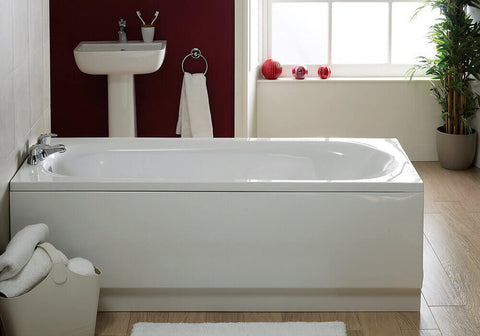Beauty, durability, affordability—these are the primary factors modern homeowners consider when choosing a bathtub. But is there a top-tier option that meets all three criteria? The answer is acrylic bathtubs! Acrylic bathtubs seamlessly blend beauty, durability, and affordability, redefining the bathing experience and becoming the preferred choice for homeowners and designers alike. Let's delve into the unique qualities of acrylic bathtubs and why they might be the ideal choice for meeting your bathing needs.

What is Acrylic
Acrylic, commonly known as special treated organic glass, is a type of plastic material derived from acrylic acid or related compounds. Its history dates back to 1872 when the polymerization of acrylic acid was first discovered. Subsequently, in 1880, the polymerization of methacrylic acid was recognized. The synthesis method for acrylic polypropylene resin was completed in 1901, and industrial manufacturing attempts were made using this method in 1927. The industrial production of methacrylic resin succeeded in 1937, marking the beginning of large-scale manufacturing of acrylic.

Initially, acrylic was primarily used in fields such as aircraft windshields and tank driver's vision blocks due to its excellent toughness and transparency. Later, due to its versatility in design, acrylic became a favored material in various industries including construction and home decoration. It wasn't until 1948 that the first acrylic bathtub was introduced, quickly gaining popularity worldwide due to its unique charm.
Acrylic bathtubs are made from acrylic sheets, with manufacturers shaping acrylic into various shapes and sizes according to demand. Eventually, the desired bathtub shape is formed through molding, resulting in a diverse range of bathtub shapes that are highly modern and customizable, enhancing bathroom aesthetics creatively.
Is an Acrylic Bathtub Worth Buying
In considering whether acrylic bathtubs are worth purchasing, it's essential to weigh the pros and cons. Ultimately, the decision depends on the user's specific needs. However, if you're seeking a stylish and cost-effective option, strongly recommend exploring the acrylic bathtub series from Giving Tree.
Pros
- Durability: Acrylic is highly resistant to scratches, stains, and fading, ensuring a long-lasting option for your bathroom.
- Lightweight: Compared to materials like cast iron or stone, acrylic is lightweight, making installation easier and reducing strain on your bathroom floor.
- Easy Maintenance: Acrylic surfaces are non-porous, making them easy to clean and resistant to the buildup of dirt, grime, and bacteria.
- Thermal Insulation: Acrylic bathtubs retain heat well, providing a comfortable bathing experience and potentially saving on water heating costs.
- Variety of Styles: Whether you prefer a modern freestanding tub or a classic alcove bathtub, acrylic can be molded into various styles to suit your preferences.
- Affordability: Acrylic bathtubs are often more budget-friendly than alternatives like fiberglass, stone, or cast iron, making them a practical choice for many homeowners.
Cons
- Prone to Stains and Scratches: Acrylic tubs can easily get stained or scratched if not properly cared for. However, these issues are fixable with simple and affordable repairs.
- Sensitivity to Cleaning Products: Acrylic tubs can be sensitive to harsh cleaners, so it's essential to use gentle cleaning materials to avoid damage. Regular use of the right cleaning products helps prevent stains and scratches.
- Color Fading Risk: While acrylic tubs are generally resistant to color fading, prolonged exposure to sunlight or harsh chemicals can cause fading or discoloration. To minimize this, keep the tub away from direct sunlight or use curtains/blinds for protection.
- May Feel Less Luxurious: If you're seeking a super luxurious option, acrylic tubs might not match up to heavier materials like steel or cast iron. While they come in various designs, some individuals may find them less substantial or "hollow" compared to other materials.
3 Types of Acrylic Bathtubs:
Acrylic Straight Tub
As the name suggests, is a type of acrylic bathtub designed with a classic rectangular shape, similar to alcove tubs. It's typically installed against a wall or on a raised platform. When purchasing such acrylic bathtubs, it's crucial to consider their dimensions, including the internal soaking dimensions and external profile dimensions, as they come in various sizes to accommodate different bathroom designs and preferences. The major advantage of these bathtubs lies in their versatile design, suitable for various bathroom layouts. However, they require professional installation and have some limitations in terms of maintenance.

Acrylic Corner Tub
Are designed to snugly fit into bathroom corners, catering to users with limited space but a preference for soaking. They maximize bathroom space utilization, making them an ideal choice for space-saving. Compared to corner bathtubs made of materials like cast iron or enamel-coated steel, the lightweight design of acrylic makes installation more convenient.

Acrylic Freestanding Tub
Different from the former two, the acrylic freestanding bathtub does not need to be flush against walls and can be placed in any area of the space. Their installation is simple, requiring only connection to the drain and plumbing for use. However, in most bathroom designs, acrylic freestanding bathtubs are typically placed outside of the shower area, making it difficult for users to enjoy both soaking and showering experiences simultaneously. Nevertheless, you can opt to complement this drawback by pairing it with a freestanding faucet.

Cleaning and Maintenance of Acrylic Bathtubs
Cleaning an acrylic bathtub is generally considered simple and effective, as its smooth and non-porous surface allows for easy maintenance. With the right care techniques, you can effectively prevent mold growth and prolong the bathtub's lifespan. Giving Tree Home always recommends performing routine maintenance every two weeks, which is a straightforward process. You only need mild cleansers and a soft cloth, then spend about 15 minutes wiping down the bathtub. If stubborn stains or limescale have formed, you can follow these steps to clean the bathtub:
- Clear Dirt: Use a soft cloth or sponge to wipe away any visible dirt or debris from the tub.
- Make Cleaning Solution: Mix a bit of mild soap with warm water to create a cleaning mix.
- Scrub Gently: Dip the cloth or sponge into the soapy water and gently scrub the tub's surface, especially focusing on stains or grime buildup.
- Rinse Well: Rinse the tub thoroughly with clean water to remove any soap left behind.
- Tackle Stubborn Stains: For tough stains, gently scrub with a mix of baking soda and water. Rinse again to remove any residue.
- Remove Hard Water Stains: Mix equal parts white vinegar and water, then apply it to hard water stains. Rinse well afterward.
- Avoid Harsh Cleaners: Don't use abrasive cleaners that can harm the acrylic surface. If needed, use a gentle scrub pad lightly.
- Dry Completely: After cleaning, dry the tub well to prevent water spots and stop mold and mildew growth.
Ending
In summary, the acrylic bathtub is a highly recommended bathing product, combining durability, practicality, and exquisite appearance, adding unique charm to your bathroom decor. However, for those pursuing high-end renovations and luxurious bathrooms, Giving Tree Home recommends solid surface bathtubs. These are typically made from high-quality materials such as quartz sand and natural minerals, offering superior quality and a luxurious feel, thereby providing you with a comfortable bathing experience.






